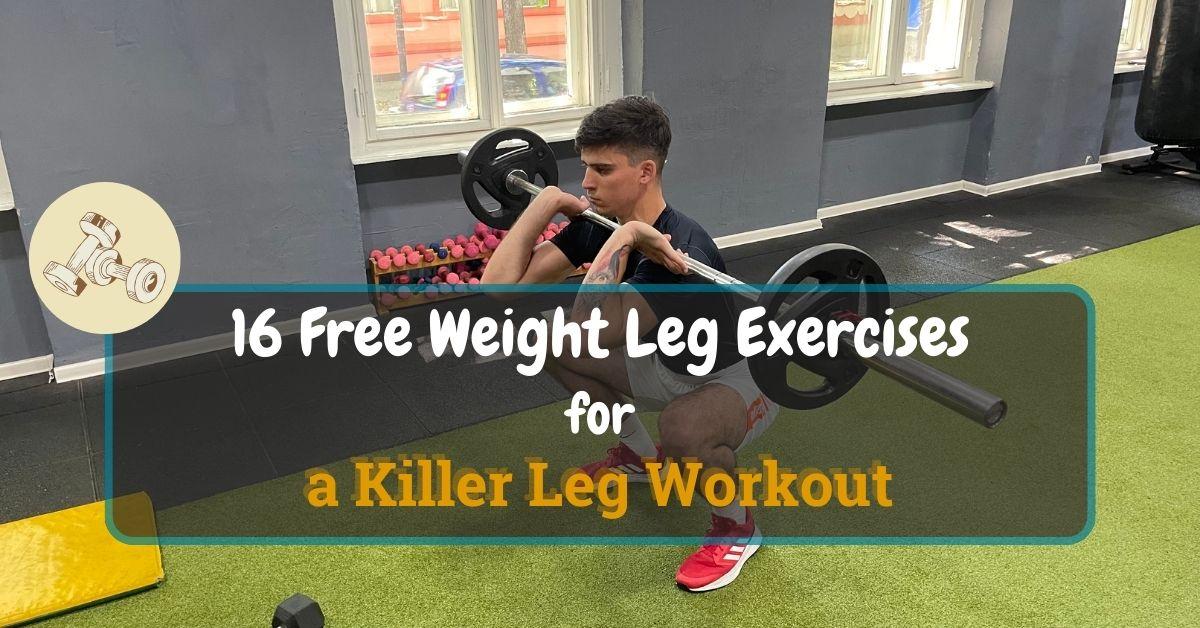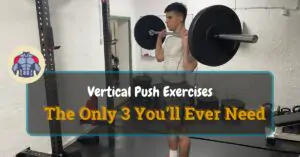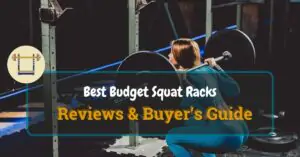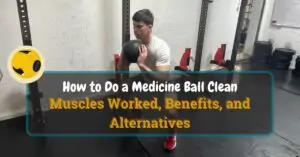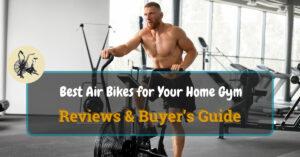Free weight leg exercises are one of the best ways to strengthen the strength, functionality, and power of your leg muscles such as quadriceps, glutes, and hamstrings.
Table of Contents
ToggleHowever, the trick lies in selecting appropriate free weight exercises and performing them with adequate technique to avoid injury and maximize performance and muscle gains.
As a Faculty of Sport and Physical Education student, it took me over 20 hours to fully research, evaluate, and single out the best leg exercises with free weights.
After reading the article, you will know the best exercises to perform with free weights, how to properly perform them, how to warm up before the free weight leg workout, the best free weight exercises according to specific lower body parts, and the best free weights for lower body training.
Start Building Your Dream Body Today
Ready to elevate your fitness game without falling into the trap of dull, repetitive routines that just don’t deliver? Imagine sculpting your ideal physique and boosting your health, all while still enjoying life’s pleasures, like those irresistible weekend getaways and your aunt’s legendary cheesecake. With our online fitness and nutrition coaching service, you don’t have to compromise. Dive into a personalized fitness journey that blends perfectly with your lifestyle, not against it. Book your completely free discovery consultation today, and take the first step towards a transformation that doesn’t require giving up the joys of life.

“I was skeptical about online fitness coaching, but Functional Body Savage completely changed my perspective. Vanja and Radomir’s personalized approach and attention to detail have helped me achieve goals I never thought possible. I’m stronger, more confident, and grateful for their guidance.”
Emily Thompson, San Francisco, CA
Learn More About Our Online Coaching ServiceQuick Summary
- The best free-weight leg exercises include barbell back squats, sumo squats, goblet squats, dumbbell squats, Bulgarian split squats, reverse lunges, dumbbell step-ups, box step-ups with dumbbells, front squats, walking lunges, and many more.
- The best way to warm up before a lower body free weight workout is to raise your body temperature, perform dynamic stretching, and activate all the muscles primarily used during the workout.
- The best free weights for building strong, powerful, stable, and functional leg muscles include kettlebells, dumbbells, and barbells.
Free Weight Leg Exercises
- Barbell Back Squat
- Sumo Squat
- Goblet Squat
- Dumbbell Squat
- Bulgarian Split Squat
- Reverse Lunge
- Dumbbell Step-Ups
- Front Squat
- Walking Lunge
- Dumbbell Squat Jump
- Barbell Deadlifts
- Romanian Deadlifts
- Single Leg Deadlift
- Calf Raise
- Lateral Lunge
- Barbell Hip Thrust
1. Barbell Back Squat
The barbell back squat is a foundational compound exercise that targets multiple muscle groups, including the quadriceps, hamstrings, gluteus maximus, erector spinae (lower back), and calves.
It’s hailed as a cornerstone of strength and conditioning programs and leg workouts due to its unrivaled effectiveness in building total body strength and mass.
You may read our guide on how to do squats correctly if you are still a beginner looking to know all the important details and rules to follow when squatting.
How to Perform a Barbell Back Squat
- Stand upright with a barbell resting on your upper back and your feet shoulder-width apart.
- Bend the hips and knees until your thighs parallel the floor.
- Keep your back straight, chest up, and knees over your toes.
- Push back up to the starting position by driving through your heels.
- Ensure your knees are not caving inwards throughout the exercise. Repeat for the desired number of reps.
2. Sumo Squat
The sumo squat is a variant of the regular squat that targets the quadriceps, gluteus maximus, hamstrings, adductor magnus (inner thigh), and calves.
The unique wider stance and foot placement in a sumo squat emphasizes the inner thigh muscles more than a regular squat.
How to Perform a Sumo Squat
- Stand with your feet wider than shoulder-width apart, toes pointing slightly outwards.
- Hold a kettlebell or dumbbell at chest level, or hang it between your legs.
- Squat down, keep your chest up, and push your knees out to remain over your toes.
- Push up to the starting position, squeezing your glutes at the top. Repeat for the desired number of reps.
3. Goblet Squat
The goblet squat is a beginner-friendly squat that targets the quadriceps, gluteus maximus, hamstrings, and core.
It’s unique because it uses a single weight held close to the chest, promoting proper squat form and posture.
How to Perform a Goblet Squat
- Stand with your feet hip-width apart, holding a kettlebell or dumbbell at chest level.
- Lower your body into a squat, keeping your chest up and ensuring your knees stay over your toes.
- Push back up to the starting position, maintaining the weight at chest level throughout. Repeat for the desired number of reps.
4. Dumbbell Squat
The dumbbell squat is an excellent full-body exercise targeting the quadriceps, hamstrings, and gluteus maximus.
Dumbbells provide a more natural range of motion than a barbell, making it a great option for beginners or those with limited mobility.
How to Perform a Dumbbell Squat
- Stand with your feet shoulder-width apart, holding a dumbbell in each hand.
- Keeping your chest up and back straight, lower your body by bending at the knees and hips.
- Push back up to the starting position once your thighs are parallel to the ground.
- Ensure your knees remain over your toes throughout the movement. Repeat for the desired number of reps.
5. Bulgarian Split Squat
The Bulgarian split squat is a unilateral exercise that targets the quadriceps, hamstrings, gluteus maximus, and core.
It also improves balance and mobility, requiring stability from your ankles, knees, and hips.
How to Perform a Bulgarian Split Squat
- Stand a couple of feet before a bench, facing away from it.
- Reach one foot back and rest the top of your foot on the bench.
- Holding a dumbbell in each hand, lower your body by bending your front knee until your thigh is parallel to the floor.
- Push back up to the starting position without letting your front knee extend beyond your toes. Repeat for the desired number of reps before switching sides.
6. Reverse Lunge
The reverse lunge is a lower-body exercise that targets the quadriceps, hamstrings, gluteus maximus, and calves.
It is generally considered knee-friendly than the forward lunge as it places less stress on the joints.
How to Perform a Reverse Lunge
- Stand with your feet hip-width apart, hands on your hips, or holding dumbbells at your sides.
- Step back with one foot and lower your body until both knees are bent at a 90-degree angle.
- Push through your front heel to return to the starting position. Repeat for the desired number of reps before switching sides.
7. Dumbbell Step-Ups
Dumbbell step-ups target the quadriceps, hamstrings, and gluteus maximus, while also engaging the core for stability.
This exercise benefits unilateral strength development and can help improve balance and coordination.
How to Perform Dumbbell Step-ups
- Stand before a bench or box, holding a dumbbell in each hand.
- Step up onto the bench with one foot, pressing through your heel to lift your body.
- Once your leading leg is straight, follow with your trailing leg.
- Step back down, leading with the same foot. Repeat for the desired number of reps before switching the leading leg.
8. Front Squat
The front squat is a lower body exercise that targets the quadriceps, gluteus maximus, hamstrings, and core.
Compared to the back squat, the front squat emphasizes the quadriceps and requires more mobility in the wrists and shoulders.
How to Perform a Front Squat
- Assume a starting standing position with your feet shoulder-width apart and a barbell resting across your shoulders.
- Lower your body by bending at the hips and knees, keeping your elbows and chest high.
- Push back up to the starting position once your thighs are parallel to the ground. Repeat for the desired number of reps.
9. Walking Lunge
The walking lunge is a dynamic lower body exercise that targets the quadriceps, hamstrings, gluteus maximus, and calves.
The walking variant of the lunge enhances balance, coordination, and unilateral functional strength.
How to Perform a Walking Lunge
- Stand with your feet hip-width apart. If desired, hold a dumbbell in each hand at your sides.
- Step forward with your right foot and lower your body until your right knee is bent at a 90-degree angle.
- Push through your right heel to stand, stepping forward with the left foot to repeat the lunge on the other side.
- Repeat the same with the left leg.
- Continue alternating legs, moving forward, for the desired number of reps.
10. Dumbbell Squat Jump
The dumbbell squat jump is a plyometric exercise that targets the quadriceps, hamstrings, gluteus maximus, and calves.
It combines strength training with cardio, increasing power, and explosiveness.
How to Perform a Dumbbell Squat Jump
- Stand with your feet hip-width apart, holding a dumbbell in each hand at your sides.
- Lower your body into a squat position.
- Explosively jump up, extending your entire body and pushing the weights towards the ceiling.
- Land softly, immediately lowering back into the squat to prepare for the next jump. Repeat for the desired number of reps.
11. Barbell Deadlifts
The barbell deadlift is a compound exercise that targets the gluteus maximus, hamstrings, quadriceps, lower and upper back, traps, and forearms.
It’s one of the most effective exercises for developing total body strength and power.
How to Perform Barbell Deadlifts
- Stand with your feet hip-width apart, shins touching the barbell.
- Bend at the hips and knees to grip the barbell with a shoulder-width grip.
- Keeping your back straight and chest up, stand up by straightening your hips and knees, lifting the barbell off the floor.
- Lower the barbell by pushing your hips and bending your knees. Repeat for the desired number of reps.
12. Romanian Deadlifts
The Romanian deadlift is a variant of the traditional deadlift that specifically targets the hamstrings, gluteus maximus, lower back, and core.
Unlike the traditional deadlift, the Romanian deadlift starts from standing and focuses more on the hip hinge.
For a detailed guide on a variation of this exercise, see our article on toes elevated Romanian deadlifts. Unlike the traditional deadlift, the Romanian deadlift starts from standing and focuses more on the hip hinge, and incorporating toes elevation can further enhance its effectiveness.
How to Perform Romanian Deadlifts
- Stand upright, holding a barbell with a shoulder-width grip, palms facing your body.
- Keep your knees slightly bent and your feet hip-width apart.
- Lower the barbell towards your feet by hinging at the hips and pushing them back. Keep your back straight and chest up.
- Once you feel a stretch in your hamstrings, reverse the movement by extending your hips to return to standing. Squeeze your glutes at the top. Repeat for the desired number of reps.
13. Single Leg Deadlift
The single-leg deadlift is a unilateral exercise that targets the hamstrings, gluteus maximus, and core.
It also improves balance, stability, and coordination, making it a great functional exercise.
How to Perform a Single-Leg Deadlift
- Stand on one leg, holding a dumbbell in the opposite hand.
- Keep your standing leg slightly bent, and don’t bend your knees once you start the exercise.
- Hinge at the hips and lower the dumbbell towards the ground while extending your free leg behind you for balance.
- Pause at the bottom, then reverse the movement, pushing your hips forward to return your lower and upper body to the starting position.
- Repeat for the desired number of reps before switching sides.
14. Calf Raise
The calf raise is a simple yet effective exercise that targets the muscles in the calves, specifically the gastrocnemius, and soleus.
How to Perform a Calf Raise
- Stand upright with your feet hip-width apart. Hold a dumbbell in each hand at your sides for added resistance if desired.
- Raise your body upward by pushing down through the balls of both feet to lift your body off the ground. Keep your abdominal muscles pulled in so that you move straight upward, not forward or backward.
- Lower your body back down. Repeat for the desired number of reps.
15. Lateral Lunge
The lateral lunge is a lower-body exercise that targets the quadriceps, gluteus maximus, hamstrings, and adductors (inner thighs).
The side-to-side motion of this lunge variant provides a great workout for the muscles of the inner and outer thighs.
How to Perform a Lateral Lunge
- Stand tall with your feet hip-width apart. If desired, hold a dumbbell in each hand at your sides.
- Take a big step to the right, pointing your toes straight ahead. Bend your right knee and push your hips back while keeping your left leg straight.
- Push off your right foot to return to the starting position.
- Repeat for the desired number of reps, then switch sides.
16. Barbell Hip Thrust
The barbell hip thrust targets the gluteus maximus, hamstrings, and core.
The exercise specifically isolates and strengthens the glutes, making it a great addition to any lower body routine.
How to Perform a Barbell Hip Thrust
- Sit on the ground with your back against a bench, feet planted firmly in front of you (toes pointed slightly outward), and a padded barbell over your hips.
- Using your glutes, push your hips up to lift the barbell. Your body should form a straight line from your shoulders to your knees at the movement’s top.
- Lower your hips to return to the starting position, ensuring you maintain control throughout. Repeat for the desired number of reps.
Related Articles:
How to Warm-up for Free Weight Leg Exercises?
To warm up for the free-weight leg exercises, you must raise your body’s temperature, perform a dynamic stretching routine, and activate muscles such as quadriceps, hamstrings, glutes, and adductors.
To raise your body’s temperature, use a treadmill at a moderate speed of 10 to 12 km/h for 3-4 minutes. A stationary bike, jump rope, or elliptical can raise your body’s temperature.
You will mostly perform athletic exercises such as high knees, butt-kicks, side shuffles, shutter steps, and similar exercises for a dynamic stretching routine. You are good to go as long as you are moving your lower body in all three planes of motion, including sagittal, frontal, and transverse.
Lastly, to activate the necessary muscles like quads, hams, glutes, and adductors, perform hip bridges, bodyweight single-leg deadlifts, hamstring floor slides, calf raises, standing banded clamshell, and similar exercises.
What Training Principles Should I Follow for a Free Weight Leg Workout?
The primary training principles you should follow for a free-weight leg workout are progressive overload, hypertrophy training principles, and recovery time.
Let’s cover all these below.
Progressive Overload
The progressive overload principle means increasing the intensity, volume, or difficulty of each following workout session.
This can be done by increasing reps and sets, decreasing rest periods, lifting more external weight, or switching to more complex and challenging exercises [1].
Hypertrophy Training Principles
Muscle hypertrophy is the process of enlarging existing muscle fibers in our body.
By hypertrophy training principles, we assume all things that will boost the enlargement of the muscle cells.
Follow the rep range between 6-12, no less than 3 sets for a single exercise, rest periods between 30 and 90 seconds, and at least 3 workout weekly sessions [2].
You can also use additional training methods such as supersets, cluster sets, and compound sets further to increase the difficulty and effectiveness of hypertrophy training.
Recovery Time
The recovery time will primarily depend on the type and size of the muscle previously targeted in the weight-lifting session.
However, the general rule to follow is to allow between 48 and 72 hours of rest between workouts targeting the same muscle groups [3].
Related Articles:
What Are the Best Free Weight Quad Exercises?
The best free weight quad exercises are goblet squats, barbell squats, dumbbell front squats, and walking lunges.
Every exercise done with free weights that includes flexion at knee joints will effectively target all four quadriceps muscles, including vastus lateralis, vastus medialis, vastus intermedius, and rectus femoris.
Free weight quad exercises are excellent for improving the overall functionality of your lower body musculature and building sufficient stabilizer strength necessary for daily movements and athletic endeavors.
If you are into more advanced quad exercises, consider incorporating a landmine hack squat in your leg workout routine.
What Are the Best Free Weight Glute Exercises?
The best free weight glute exercises include Romanian deadlifts, sumo squats, dumbbell hip thrusts, and reverse lunges.
Every exercise that requires hip extension will effectively activate glute muscles, such as the gluteus maximus, medius, and minimus.
Free weight glute exercises are essential for everyone who seeks to build lower body strength and explosive hip power, which perfectly translates for different sports but also helps stabilize the spine and prevent lumbar pain.
What Are the Best Free Weight Calf Exercises?
The best free-weight calf exercises include single-leg raises, standing dumbbell calf raises, donkey calf raises, and Smith machine calf raises.
Calf muscles, gastrocnemius, and soleus are essential for helping ankle plantarflexion and are used during jumping activities and absorbing the force when landing after jumping.
Free-weight calf exercises are often neglected as many lifters prefer only to exercise muscles that can be seen in the mirror.
Still, these muscles are extremely important to keep the knee and ankle joints healthy and without injuries.
FAQs
Can You Train Legs With Free Weights?
Yes, you can train your legs with free weights. Free weights such as kettlebells, dumbbells, and barbells are the best types of free weights to make your legs bigger, stronger, and, most importantly, more functional.
How Do You Use Dumbbells for Legs?
You use dumbbells for legs by performing a dumbbell leg workout consisting of exercises such as split squats, regular dumbbell squats, sumo squats, rear-foot elevated split squats, single-leg deadlifts, calf raises, and many more. Dumbbell leg exercises are excellent for improving your lower-body strength, muscle hypertrophy, and functionality since they require substantial stabilizer activation.
How Can I Do Legs Without Squats?
You can do legs without squats by performing leg presses, hip bridges, deadlift variations, and many more isolation exercises such as calf raises, leg extensions, and banded hip abduction. However, squats are essential for building strong and functional lower body muscles such as quadriceps, glutes, and hamstrings.
Should I Use Weights for Legs?
Yes, you should use weights for your legs. You should use weights for your legs because external resistance is essential for growing and making your legs stronger and more functional.
Are Squats Necessary?
Squats aren’t necessary. However, squats are the most efficient lower body exercise for building leg strength and power, so you wouldn’t probably want to skip them in your workouts unless you want to perform barbell back squats and feel pain in your lower back.
What Are the Best Free Weights for Building Strong and Muscular Legs?
The best free weights for building strong and muscular legs are kettlebells, dumbbells, and barbells.
These free weight types and gym equipment are essential for building strong stabilizer muscles and making your lower body more functional by enabling you to use the strength in real-life situations, on track, and during competitive games.
If you believe these types of free weights are for you, I suggest reading our guides on these types of gym equipment that will enable you to pick the best product according to your budget, needs, and goals:
Let me know your thoughts on the best free-weight leg exercises and why you believe they are necessary for building a strong and functional lower body.
Start Building Your Dream Body Today
Ready to elevate your fitness game without falling into the trap of dull, repetitive routines that just don’t deliver? Imagine sculpting your ideal physique and boosting your health, all while still enjoying life’s pleasures, like those irresistible weekend getaways and your aunt’s legendary cheesecake. With our online fitness and nutrition coaching service, you don’t have to compromise. Dive into a personalized fitness journey that blends perfectly with your lifestyle, not against it. Book your completely free discovery consultation today, and take the first step towards a transformation that doesn’t require giving up the joys of life.

“I was skeptical about online fitness coaching, but Functional Body Savage completely changed my perspective. Vanja and Radomir’s personalized approach and attention to detail have helped me achieve goals I never thought possible. I’m stronger, more confident, and grateful for their guidance.”
Emily Thompson, San Francisco, CA
Learn More About Our Online Coaching ServiceReferences:
- https://www.ncbi.nlm.nih.gov/pmc/articles/PMC4215195/
- https://www.ncbi.nlm.nih.gov/pmc/articles/PMC6950543/
- https://www.ncbi.nlm.nih.gov/pmc/articles/PMC6719818/

